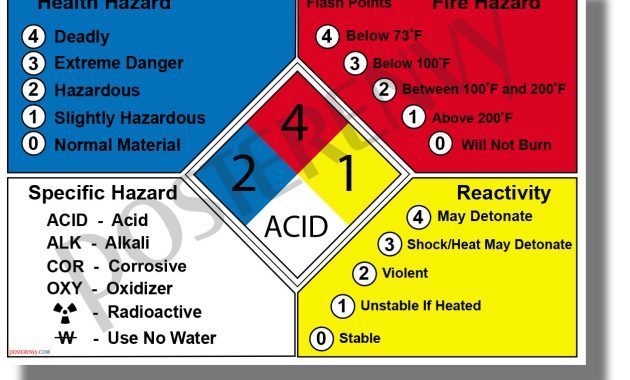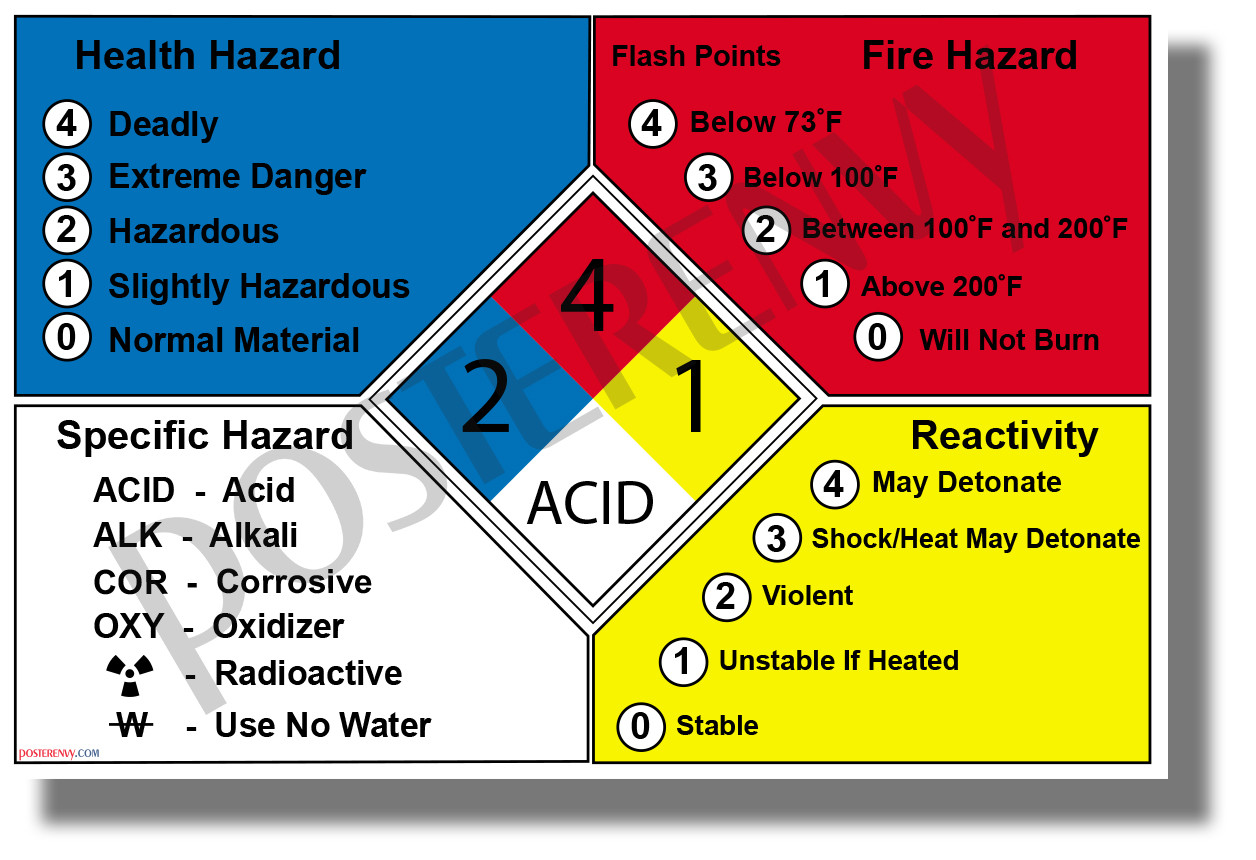
Decoding the Diamond Hazard Label: A Guide to Workplace Safety
In the realm of workplace safety, understanding and adhering to hazard communication standards is paramount. One of the most critical tools in this endeavor is the diamond hazard label, a visual representation of potential dangers associated with specific chemicals and materials. This guide provides a comprehensive overview of the diamond hazard label, its components, and its importance in ensuring a safe and compliant work environment.
Understanding the Purpose of the Diamond Hazard Label
The primary function of the diamond hazard label, also known as the NFPA 704 hazard identification system, is to quickly and effectively communicate the hazards of a material to those who may come into contact with it. This system, developed by the National Fire Protection Association (NFPA), uses a standardized diamond-shaped symbol divided into four colored sections. Each section represents a specific type of hazard, allowing for immediate identification of potential risks.
Breaking Down the Diamond: The Four Hazard Categories
The diamond hazard label is divided into four sections, each representing a specific hazard category. Understanding these categories is crucial for interpreting the information provided by the label:
- Health Hazard (Blue): This section indicates the level of health hazard associated with the material. Numbers range from 0 (no hazard) to 4 (deadly). This rating considers the potential for short-term and long-term health effects upon exposure.
- Flammability Hazard (Red): This section identifies the flammability of the material. The numbers range from 0 (will not burn) to 4 (extremely flammable). This rating considers the flash point and ability of the material to ignite and sustain a fire.
- Instability Hazard (Yellow): This section indicates the instability or reactivity of the material. Numbers range from 0 (stable) to 4 (may detonate). This rating considers the potential for the material to react violently, potentially leading to explosions or other hazardous events.
- Specific Hazard (White): This section provides information about specific hazards that are not covered in the other three categories. Common symbols include:
- OX: Oxidizer
- W: Reacts with water
- COR: Corrosive
- ACID: Acid
- ALK: Alkali
- ☢: Radioactive
Reading the Diamond: Deciphering the Numbers and Symbols
Each section of the diamond hazard label contains a number ranging from 0 to 4, indicating the severity of the hazard. A higher number signifies a greater risk. The white section may contain specific symbols or codes to provide additional information about unique hazards. Understanding the numerical ratings and associated symbols is key to quickly assessing the potential dangers of a material.
The Importance of the Diamond Hazard Label in Workplace Safety
The diamond hazard label plays a vital role in promoting workplace safety. It provides critical information for:
- Emergency Responders: First responders use the label to quickly assess the hazards present at a scene, enabling them to take appropriate safety measures.
- Workers: Employees can use the label to understand the hazards of the materials they are working with, allowing them to take necessary precautions, such as wearing personal protective equipment (PPE).
- Facility Management: The label assists in proper storage and handling of hazardous materials, minimizing the risk of accidents and spills.
- Compliance: The diamond hazard label is a key component of hazard communication standards, helping businesses meet regulatory requirements and avoid penalties.
Best Practices for Using the Diamond Hazard Label
To ensure the effectiveness of the diamond hazard label, it is essential to follow best practices:
- Proper Labeling: Ensure that all hazardous materials are properly labeled with the correct diamond hazard label.
- Training: Provide comprehensive training to employees on how to read and interpret the diamond hazard label.
- Regular Inspections: Conduct regular inspections to ensure that labels are in good condition and that materials are stored correctly.
- Material Safety Data Sheets (MSDS): Always consult the Material Safety Data Sheet (MSDS) or Safety Data Sheet (SDS) for detailed information about a material’s hazards, properties, and handling procedures.
- Update and Review: Regularly update labels and review hazard assessments to reflect changes in the materials used or the hazards present.
Beyond the Basics: The Evolution of Hazard Communication
The diamond hazard label remains a cornerstone of hazard communication. However, it’s important to note its relationship to the Globally Harmonized System of Classification and Labelling of Chemicals (GHS). The GHS aims to standardize hazard communication worldwide. While the NFPA 704 system is still widely used, especially in North America, the GHS uses pictograms and standardized signal words to communicate hazards. Familiarity with both systems is beneficial for those working with hazardous materials.
The Impact of Incorrect Diamond Hazard Labeling
Incorrectly labeling materials with the wrong diamond hazard label can have severe consequences. This can lead to:
- Increased Risk of Accidents: Employees and emergency responders may not be aware of the true hazards, increasing the risk of accidents, injuries, and fatalities.
- Environmental Damage: Improper handling of hazardous materials due to incorrect labeling can lead to spills, leaks, and environmental contamination.
- Legal Penalties: Businesses that fail to comply with hazard communication regulations may face significant fines and other penalties.
- Damage to Reputation: Accidents caused by incorrect labeling can damage a company’s reputation and erode public trust.
Ensuring a Safer Workplace: The Role of the Diamond Hazard Label
The diamond hazard label is an essential tool for promoting a safer work environment. By understanding its components, correctly interpreting its information, and adhering to best practices, employers and employees can significantly reduce the risk of accidents and injuries. The effective use of the diamond hazard label underscores a commitment to safety, compliance, and the well-being of all workers.
Consider this your guide to understanding and utilizing the diamond hazard label to its fullest potential. Proper use protects workers and the environment. It is an essential element in any comprehensive safety program.
Conclusion: Prioritizing Safety with the Diamond Hazard Label
The diamond hazard label is more than just a sticker; it is a critical communication tool in the realm of workplace safety. By understanding its components and adhering to best practices, organizations can significantly reduce the risks associated with hazardous materials. Remember, the diamond hazard label is a vital key in creating a safer work environment.
In conclusion, the diamond hazard label is essential. It protects workers and communities. Prioritizing safety with the diamond hazard label is a responsible choice.
[See also: Related Article Titles]

